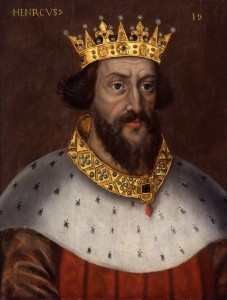12.01
On December 1, 1135, Henry I of England died. He was King of England from 1100 to 1135, he was the youngest son of William the Conqueror, and succeeded his brother William II. He won the support of the Saxons by granting them a charter and marrying a Saxon princess, Edith, daughter of Malcolm III of Scotland. She was known as Matilda after her marriage, a name more acceptable to the Norman Barons than her Saxon name Edith. Henry’s daughter was also called Matilda. He was nicknamed “Beauclerc” (fine scholar) for his above average education. During his reign, the differences between English and Norman society began to slowly evaporate. The stability Henry afforded the throne was offset by problems in succession: his only surviving son, William, was lost in the wreck of the White Ship in November 1120.
The first years of Henry’s reign were concerned with subduing Normandy. He was also drawn into controversy with a rapidly expanding Church. By 1106, both the quarrels with the church and the conquest of Normandy were settled and Henry concentrated on expanding royal power. He mixed generosity with violence in motivating allegiance to the crown and appointing loyal and gifted men to administrative positions. By raising men out of obscurity for such appointments, Henry began to rely less on landed barons as ministers and created a loyal bureaucracy. He was deeply involved in continental affairs and therefore spent almost half of his time in Normandy, prompting him to create the position of justiciar – the most trusted of all the king’s officials, the justiciar literally ruled in the king’s stead. Roger of Salisbury, the first justiciar, was instrumental in organizing an efficient department for collection of royal revenues, the Exchequer. The Exchequer held sessions twice a year for sheriffs and other revenue-collecting officials; these officials appeared before the justiciar, the chancellor, and several clerks and rendered an account of their finances. The Exchequer was an ingenious device for balancing amounts owed versus amounts paid. Henry gained notoriety for sending out court officials to judge local financial disputes (weakening the feudal courts controlled by local lords) and curb errant sheriffs (weakening the power bestowed upon the sheriffs by his father).
The final years of his reign were consumed in war with France and difficulties ensuring the succession. The succession became a concern upon the death of his son William in 1120: Henry’s marriage to Adelaide was fruitless, leaving his daughter Matilda as the only surviving legitimate heir. She was recalled to Henry’s court in 1125 after the death of her husband, Emperor Henry V of Germany. Henry forced his barons to swear an oath of allegiance to Matilda in 1127 after he arranged her marriage to the sixteen-year-old Geoffrey of Anjou to cement an Angevin alliance on the continent. The marriage, unpopular with the Norman barons, produced a male heir in 1133, which prompted yet another reluctant oath of loyalty from the aggravated barons. In the summer of 1135, Geoffrey demanded custody of certain key Norman castles as a show of good will from Henry; Henry refused and the pair entered into war. Henry’s life ended in this sorry state of affairs – war with his son-in-law and rebellion on the horizon – in December 1135. Henry died on December 1, 1135 in Normandy of food poisoning according to legend from eating a ‘surfeit of Lampreys’ (an eel type fish). His remains were sewn into the hide of a bull to preserve them, and then taken back to England and buried at Reading Abbey. The Abbey was destroyed during the Protestant Reformation and no trace of his tomb has survived, the probable site being covered by St. James’ School.












